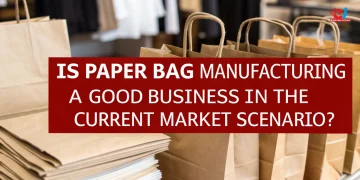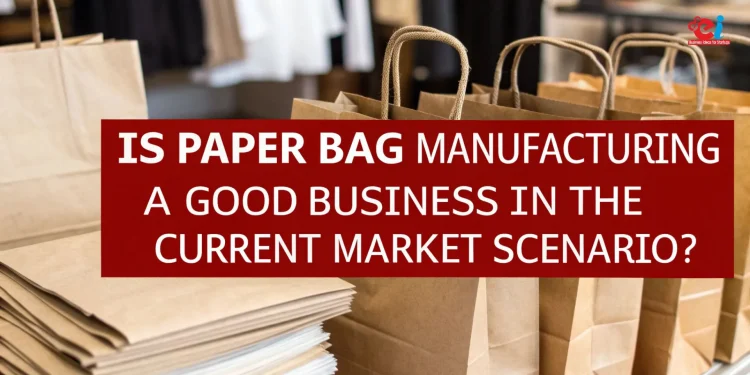The humble paper bag manufacturing is making a comeback in an age of sustainability and eco-conscious consumption. Was once a simple utility item, it has evolved today into a symbol for environmental responsibility, retail innovation, and branding. In India, the increasing awareness of plastic pollution and government regulations have catalyzed the demand for alternatives. Paper bags are at the forefront.
The question that arises for entrepreneurs looking to explore manufacturing opportunities within the green economy is — Is paper bag manufacturing a viable business under today’s market conditions? The short answer is: Yes. To fully understand the potential of this industry, it is important to look at its market dynamics, manufacturing process, and long-term viability.
The rise of paper bags in India: what’s driving the demand?
In the past decade, packaging preferences have changed dramatically, both for businesses and consumers. Plastic bags, which were once the most convenient packaging solution, are now seen to be hazardous and unsustainable. India, one of the world’s largest plastic consumers, had to face this reality. The government has implemented a phased-in ban on single-use plastics, including carry bags and is encouraging the use of biodegradable alternatives.
Paper bags have become a necessity due to the regulatory change and increased environmental awareness. Urban supermarkets and retail chains have begun to transition from plastic packaging to paper-based packaging. Paper bag manufacturing have evolved from a localized, low-scale trade into a growing and structured manufacturing industry.
The consumer’s behavior has changed as well. The buyer of today, particularly in metros or tier-2 cities, is willing to pay more for sustainable packaging. Branded paper bags are more than just carriers. They’re now tools to engage customers and tell environmental stories.
Related: Packaging Business – which sectors are coming up in this industry to invest?
Market Size, Demand Trends, and Growth Forecast
In order to evaluate the business potential for paper bag production in the future, it’s important to look at the market and demand forecasts.
The global paper bag market is estimated to reach USD 5.4 billion by 2022. The market is expected to reach USD 8.2 billion in 2028. This will grow at a CAGR of around 6.5%. India’s growth is even stronger. The Indian paper bag industry is expected to grow 7.2% CAGR over the same period, driven by regulatory pressures and increasing demand from the organized retail and e-commerce sectors.
This growth is particularly noteworthy because it crosses all sectors. Paper bag are not only used for retail shopping. Paper pouches with flat bottoms are becoming more popular in pharmacies. The food delivery platforms insist on using recyclable kraft paper bags. For an upscale appearance, luxury gifting companies prefer paper bags with rope handles and laminated handles. Even corporate events and institutional promotions use printed paper bags in place of plastic folders.
Interesting, India is also experiencing a growing demand for printed paper bags of high quality. Paper bags are being imported from India by countries in Europe, the Middle East, and Asia to meet sustainability goals. This is a great opportunity for Indian manufacturers who have export capabilities.
India’s growing retail ecosystem reinforces the growth potential. The organized retail sector is projected to reach USD 230 billion in 2030, and e-commerce penetration will increase rapidly both in urban and semi-urban areas. Packaging demand, including paper bags, will therefore surge.
The Market Niches for Paper Bags
Paper bags are available in a variety of sizes, shapes and designs, depending on the intended use. Each segment has its own market dynamics and profitability. In bakeries, pharmacies, and grocery stores, flat paper bags are used for lighter goods. In restaurants and food delivery companies, gusseted bags or satchel bags are preferred as they provide more volume and stability.
Handle bags, both flat and twisted, are used widely in supermarkets and fashion retail. When customized with logos of brands, these bags serve a dual purpose: they carry goods while reinforcing the brand’s identity. These bags are used for high-end brands, and they’re often found in packaging, such as cosmetics, clothing or gift items. They are usually glossy or matte and can include special printing effects to increase their perceived value.
Entrepreneurs who enter this market can specialize in one segment or provide a range of products based on the needs of their clients. Customization, both in design and functionality, increases the scalability of a business and its ability to retain customers.
The Manufacturing Process: Raw Paper to Functional Bags
Entrepreneurs who are interested in entering the sector must understand the process of making paper bags. Automation has decreased labor dependency for large-scale units. However, many small and medium-sized units still use semi-automatic setups. This makes it a viable venture for MSMEs.
Raw materials are typically kraft, white, or recycled papers. The GSM (grams per square meter) of paper can vary depending on the bag type and target market. This will affect both the cost and the strength. After the paper has been sourced, the paper can be printed or fed directly into the cutting machine.
Flexographic or offset printing can be done before cutting if customization is needed. The printing machines can print logos, patterns, colors, and brand colors. After printing, the paper will be cut into strips or sheets according to the size intended for the bag.
The sheets are then fed into bag-making machines, which fold, glue and shape the bag. Some setups require the bottom and sides to be manually glued. This is especially true for lower production volumes. Handle bags are made using a different process where the handles can be either machine-glued or manually attached, depending on automation.
After the bags have been formed, they are dried and stacked. The final quality check is done to ensure that the bags are strong, aligned, and adhere well. With moderate training, workers can quickly become skilled in machine operation and quality control.
Related: Production of Eco-Friendly Bamboo-Based Products: Tissue Paper, Paper Bags & Plates
Startups and Small Businesses have many opportunities
Paper bag production is becoming increasingly popular among entrepreneurs because it is accessible. Paper bag production is not a heavy industry that requires large capital investments, complex machinery and pollution clearances. It can be started with a small to medium-sized facility using semi-automatic equipment and fewer staff. It is therefore a perfect fit for small businesses, women-led companies, rural and semi-urban manufacturing projects, as well as startups.
Paper bag models also fit well with social enterprise models. Paper bag making has been adopted as a viable livelihood option by many self-help groups, women cooperatives and community development projects. The MSME Ministry, as well as various state-level Industrial Development Boards, provide assistance, training and marketing for these ventures.
Scalability is another reason why the business model is appealing. As demand grows, manufacturers can move to fully automated machines and add new products (such as laminated bags and boxes) or even contract manufacturing for large retailers.
Paper Bag Industry: Addressing Challenges
Paper bag manufacturing is no different. Price competition is one of the main issues. Price competition is becoming more important as more players enter the marketplace. Differentiation can help – offering better quality, custom designs or sustainable printing.
A common problem is sourcing raw materials. Paper prices fluctuate because of changes in the global pulp supply and domestic recycling rates. Entrepreneurs are advised to explore multiple suppliers and to look at options such as recycled paper or internal recycling in order to reduce their dependence on the market.
Quality can be affected by a lack of skilled labor, particularly in rural areas. Regular training, the adoption of basic quality control systems and machine maintenance are all ways to overcome inefficiencies.
Waste management must also be considered to meet environmental commitments. The majority of units recycle scraps and offcuts to reduce waste and improve their environmental credentials.
What makes this industry future-proof?
Paper bags are expected to grow and remain relevant in the future, unlike other manufacturing sectors, which can be affected by seasonal trends or regulations. Globally, the paper bag industry is firmly rooted in circular economy models. India’s drive for plastic-free towns and brand CSR commitments are also a major factor.
A rise in direct-to-consumer brands and local artisans has also created a need for low-volume, aesthetically pleasing boutique packaging. Small-scale manufacturers can benefit from this trend because they are able to offer customization and a quick turnaround.
Digital marketing plays an important role in this. Many paper bag producers are now reaching their customers online via B2B portals and social media — allowing them the opportunity to compete outside of their local geography.
For more information, check out this video
How NPCS supports paper bag manufacturing ventures
Niir Project Consultancy Services provides valuable assistance to entrepreneurs who want to evaluate and implement a business plan professionally. NPCS offers Market Study and Detailed Techno-Economic Feasibility Reports for the paper bag industry. These reports cover all critical aspects, including manufacturing process, raw material selection and plant layout design.
NPCS has decades of experience guiding industrial ventures. It helps entrepreneurs assess the feasibility of setting up a new business, ensuring their decisions are informed, data-backed and strategic.
Which business to start? How to choose a business idea?
Final Thoughts – A Sustainable Opportunity with Solid Fundamentals
Paper bag manufacturing is not a marginal activity anymore. It is a business with high potential, aligned to modern sustainability goals and changing consumer preferences. This industry is a great place for first-time entrepreneurs as well as experienced manufacturers looking to diversify.
Paper Bag Production is a Business that’s Not Only Viable, But Also Necessary. This venture, with the right planning, quality focus and market positioning can provide financial sustainability, while also contributing to environmental wellbeing — a rare combination which defines future-ready entrepreneurialism.


















